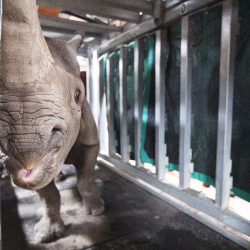Faculty from the MSU College of Veterinary Medicine, MSU Extension educators, and local veterinary practitioners partner every year to conduct Bull Breeding Soundness Examinations (BSE) around the state. During these clinics, we set up at local farms and farmers bring their bulls to us to check their fertility going into the spring breeding season. We made our annual trek to the Upper Peninsula and Northeast Lower Peninsula during the last week in April. Here are some of the highlights.
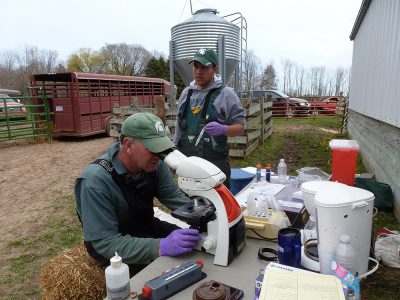
Day 1
The East Lansing MSU-based team consisting of Dr. Oscar Benitez and me headed out from MSU at 4:00 a.m. for Cooks, Michigan, where we met Dr. Renee Coyer from Thompson Veterinary Clinic, Frank Wardynski, an MSU Extension educator based in the UP, and Cody Pollins, a fourth-year veterinary student doing a clinical rotation at Thompson Veterinary Clinic. We arrived at 9:00 a.m. at the farm of Jon Haindl to find rain, wind, and 38 degree weather conditions. Jon had recently broken his foot so he was unable to help us, but his hired hands did a great job. Five hours later, we had tested 19 bulls. We headed into Manistique for some Chinese food and then to our hotel to get clean and warm!
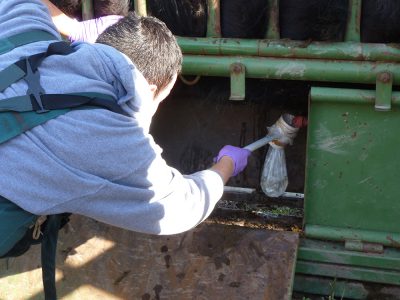
Day 2
The team split up with me, Coyer, and Wardynski heading to the Garden Peninsula to test bulls, while Benitez and Pollins headed to the MSU Upper Peninsula Experiment Station, located in Chatham. They were collecting blood from the cow herd to screen for Bovine Leukosis Virus (BLV). As part of a USDA funded project, the College is working with beef producers around Michigan to learn more about the effects of BLV on the productivity of beef cattle herds.
In addition, we are screening bulls for the presence of BLV in semen and smegma and evaluating how these secretions may serve as a source of virus transmission. The origins of the term "smegma" and what exactly smegma is became a topic of conversation and learning objective for Cody (more to come).
The Garden team joined the Chatham team in the afternoon to test more bulls. We tested 34 bulls by the end of the day. We then had pizza at the Saloon in Gladstone. Highly recommended!
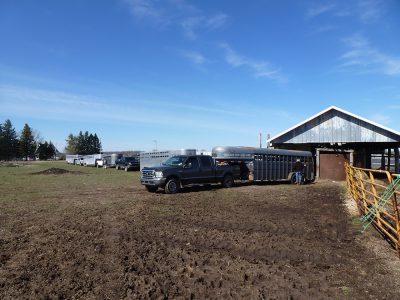
Day 3
We went to Bark River where we spent the entire day testing bulls at the farm of Mert and Scott Wallace. The highlight of the day was the lunch made by Virginia Wallace featuring her famous broccoli salad. We tested 42 bulls for 14 farmers. On the two hour drive from Bark River to Baraga (our overnight stop), Cody reported on his findings about smegma. Smegma is a whitish-yellow material composed of shed epithelial cells (dead skin) and sebum (oily secretions) produced by the sebaceous glands of male and female genitalia. The word "smegma" comes from the Greek term for "soap." Hmmm. Job well done, Cody!

Day 4
Thursday was a busy day with stops in Pelkie, Ontonagon, and Iron River. A cool fact: drive time from East Lansing to Ontonagon is eight hours and fifteen minutes. Drive time from East Lansing to Washington D.C. is eight hours and thirty minutes.
In Pelkie, we talked about a young bull that was bought in South Dakota and was not producing good semen. In Ontonagon, we discussed the issue farmers are having with wolves preying on newborn calves. In Iron River, we talked about vaccine programs and BLV.
Cody is fully trained to do BSE’s and did a great job. We left Iron River at 6:00 p.m. with the goal of making it back to the Mackinaw Bridge for the night. Along the way, we dropped off Wardynski, Kohn, and Cody. We tested 30 bulls that day.
Day 5
Grooms and Benitez made stops in Mio, Curran, Glennie, and Harrisville to test bulls. These farms are located in the Michigan TB zone, which makes it difficult to move animals off the farm. So we stopped at their farms to make sure they have good bulls for the upcoming breeding season. We tested 26 bulls and then headed to Oscoda for the night. Every night, there is paperwork and lab work to do in the hotel. Makes for long days and evenings!
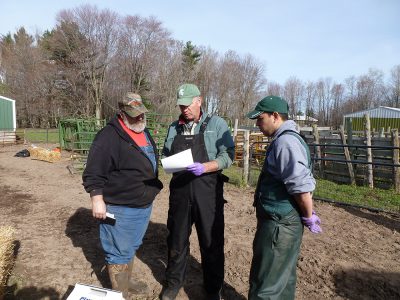
Day 6
We met up with Phil Durst in Northeast Michigan and headed to Prescott for our last day. Both Grooms and Benitez were tired, sore, and ready to go home. The week of hotels and bed and breakfasts was taking its toll. We hoped for a smooth and efficient day.
That's not what we got. We were only expecting 20 bulls, but 36 showed up. At one point, we had eight trailers lined up. Two bulls got out of the corral (they are still out!). The head gate broke. A truck got stuck. Benitez’s back was sore. I was whipped. Durst kept us focused. Finally, we finished at 4:00 p.m. We tested 34 bulls (remember, two still running!). Benitez and I arrived back at MSU at 6:30 on Saturday evening.
Final stats: 1,413 miles, 12 stops, 51 farmers served, 185 bulls tested, 23 (12%) did not pass BSE, two bulls still running! Teaching, Research, Outreach, and Service in Six Days! Impact: priceless!


